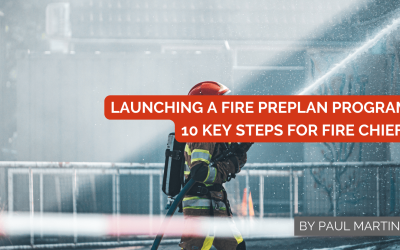
There’s no getting around it – data is everywhere these days.
And for good reason. From businesses using data to make decisions instead of instinct, to governments employing data science to improve service delivery, to sports teams using advanced metrics to squeeze maximum value out of every situation, data-driven decision-making has made a huge impact already. And it’s here to stay.
You can see that impact by just how fast the world’s collective data is growing. Many organizations now generate and store vast amounts of data, and a recent report says the total amount of data in the world will grow by 61 percent over the next few years, reaching around 175 zettabytes by 2025. Fire services need to wade through these vast quantities of data to determine what is relevant and immediate to be more effective in serving the public.
Is Your Fire Department Using Its Data?
This all means one thing: If you’re not getting the essential data to help make decisions and optimize your operations, you’re likely falling behind. This jeopardizes your response effectiveness and potentially the lives of your members. Further, you’re costing your team valuable time that can be used in more effective ways and leaving municipal funds on the table.
If you’re not getting the essential data to help make decisions and optimize your fire departments, you’re jeopardizing your response effectiveness.
The Data is There. Why Aren’t Fire Services Using It?
There are, of course, many reasons why data continues to be a wicked problem for fire services across North America. Resistance to change is one of the main culprits. Many departments are neither resourced to take advantage of the available information currently out there nor are they able to see the tangible benefits for their responders. These problems don’t just lead to inefficiencies and confusion. They also make firefighters, and their communities, less safe. This is due to the lack of a platform that integrates their data and presents just the right amount of data needed for informed fire ground decision-making.
What Happens When You Leave Your Data Behind
Imagine if awareness of inspection report deficiencies and up-to-date fire pre-plan reports are made available to fire fighters en route to fire. Might this affect their decisions on the fire ground? Would availability of such information to responders have changed the outcome of the tragic Ghost Ship warehouse fire which resulted in 36 lost lives or other fires?
Having served various fire organizations in several capacities, I’ve seen these issues first-hand. Paper pre-incident plans often get lost in the back of trucks, and even if they do get filed are next to impossible to quickly find in an emergency. Most record management systems that hold pre-plan information require time-consuming and repetitive data entry at the station, often have password and access issues, and usually don’t yield very good results anyway thanks to long loading times in situations where seconds count. These systems are also only as good as the next firefighter collecting the data.
The good news? New technologies and applications are being implemented by fire services across North America at a faster rate than ever before.
There are positive signs that we may finally be able to solve the data wicked problem. Many forward-thinking fire services are taking advantage of the data revolution to improve service and – quite frankly – make data collection and access less of a pain for rank-and-file firefighters. Our current fire fighters are also more tech savvy and expecting our services to keep up. Service providers are quickly responding to fire services’ needs by presenting low cost platforms able to integrate the needed information. Pre-incident planning can now be shared across the service with fire prevention inspection observations and incident history tied to Google Maps. This info is available to apparatus as they respond in simple to use platforms.
The Monterey Fire Department, for example, used to take up to 12 hours using legacy methods to complete or update tactical pre-incident plans of buildings and sites in its jurisdiction. But after implementing a cloud-based mobile application for pre-planning, the same process now takes around 20 – 45 minutes from start to finish – while also yielding far better and more consistent information. The department has seen a 20-per-cent cost savings while also achieving its annual pre-plan targets: A win-win.
At the end of the day, we’re all looking to protect our communities and our firefighters. And there’s no question the effective use of data can help us do that better than ever before. With current platforms available it has never been in a better time to solve the fire service wicked data problem.
The fire service must embrace data-driven decision-making to optimize their operations, save lives, and better serve their communities. By leveraging data to enhance incident response, inform prevention efforts, improve training, justify budgets, and promote accountability, fire departments can ensure they remain agile and effective in an increasingly complex world. The importance of taking data seriously cannot be overstated, as it has the potential to revolutionize the way fire services operate and protect their communities.

Author Sean Tracey
Sean Tracey is a former 20-year veteran of the Canadian Forces, serving as a Military Engineering Officer and the Canadian Forces Fire Marshal. In 2000, he was appointed the first ever Canadian Regional Director for NFPA. He also served in the Ottawa Fire Service as Deputy Chief Training, Safety & Innovation, and is a past Director of the Canadian Council of Fire Marshals and Fire Commissioners and the Ontario Fire Marshal Public Fire Safety Council. Sean is a Board member of the Ottawa First Responders Foundation, and co-chair of the Codes Committee for the Canadian Association of Fire Chiefs. In 2015, he was awarded the grade of Fellow with the Institution of Fire Engineers.

Watch The Webinar!

Why Fire Preplans Are Critical for All Fire Response
Why Fire Preplans Are Critical for All Fire Response Pre-incident planning, also known as a fire preplan, is a proven method of mitigating risks, enhancing firefighter preparedness, and improving the overall efficiency of emergency responses, resulting in better...


